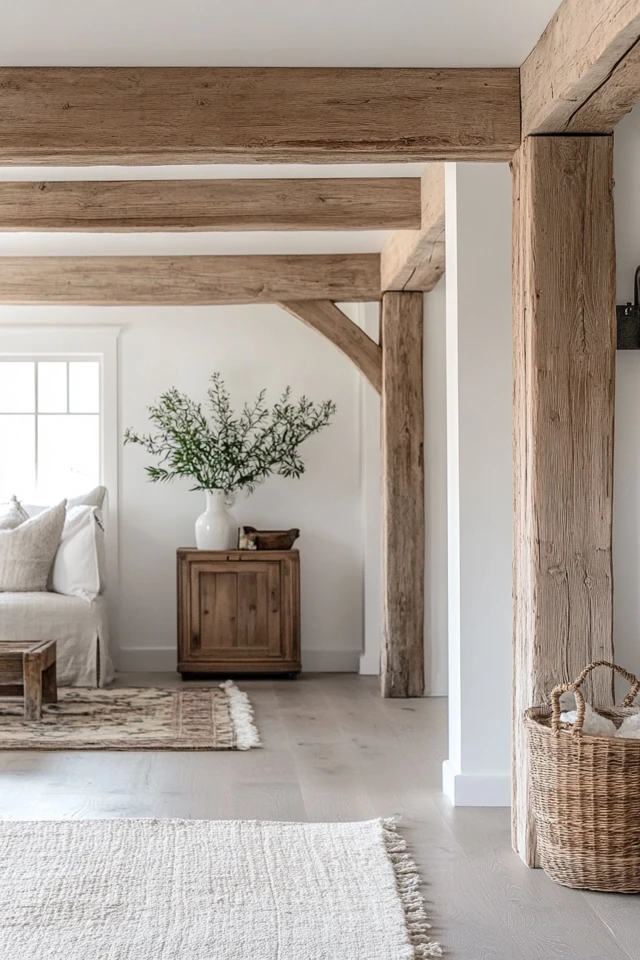Introduction
The combination of white and wood is a hallmark of farmhouse interiors. Together, these elements create a space that feels warm, inviting, and timeless. White brings lightness and brightness to the room, while wood adds warmth, texture, and character. Whether you’re decorating a modern farmhouse or a traditional cottage, this pairing offers endless possibilities for creating a cozy, lived-in aesthetic.
I first discovered the magic of white and wood while renovating my kitchen. I paired crisp white cabinetry with rustic wooden shelves, and the transformation was incredible. The space felt brighter, more open, and instantly more inviting. Since then, I’ve incorporated this combination throughout my home, from white walls with reclaimed wood beams in the living room to a whitewashed dining table with natural wood chairs. Every room feels balanced, cohesive, and full of charm.
If you’re looking to embrace the beauty of white and wood in your farmhouse interiors, this guide will show you how to strike the perfect balance between these two timeless elements.
The Perfect Design for You
Combining white and wood is ideal for anyone who loves the simplicity and warmth of farmhouse style. Whether you’re starting from scratch or updating an existing space, this design approach is versatile and adaptable to any room.
The beauty of white and wood lies in their contrast. White brightens the space, making it feel open and fresh, while wood grounds the design, adding depth and texture. Imagine white shiplap walls with dark wooden beams, a natural wood coffee table against a white sofa, or a bright white kitchen with warm wood accents. This pairing works beautifully in kitchens, living rooms, bedrooms, and beyond.
Picture Gallery
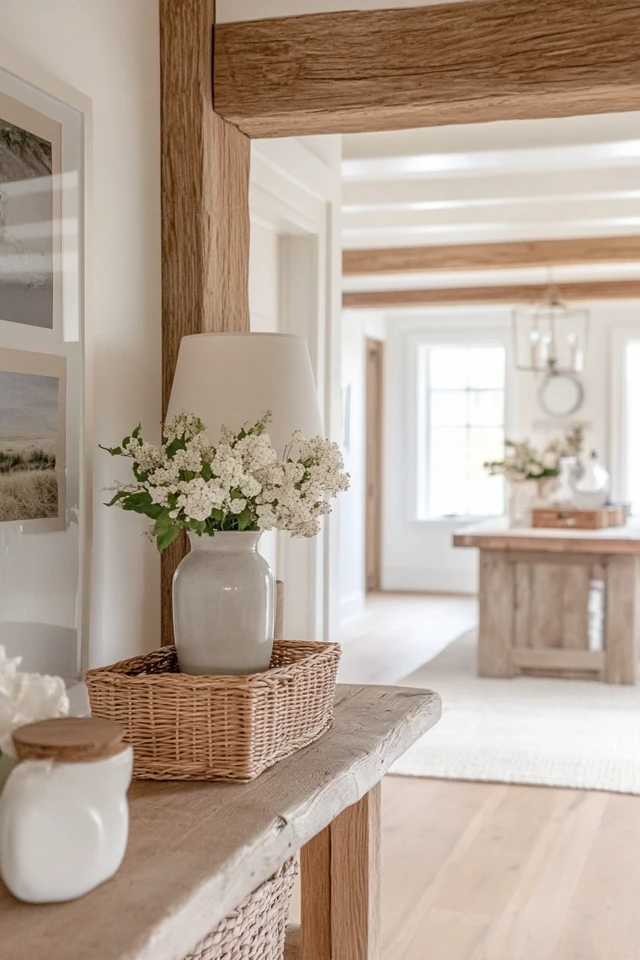

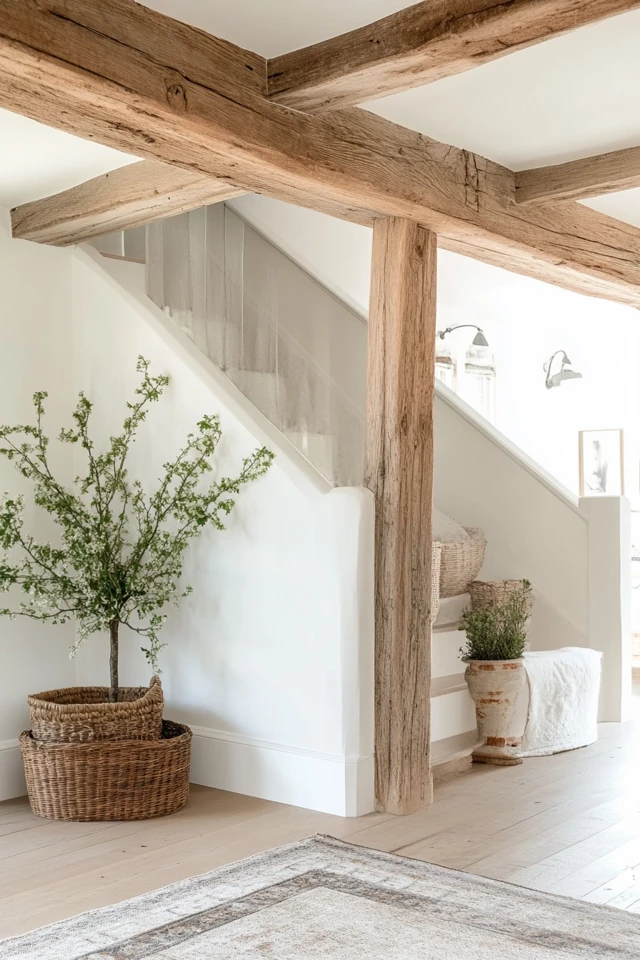
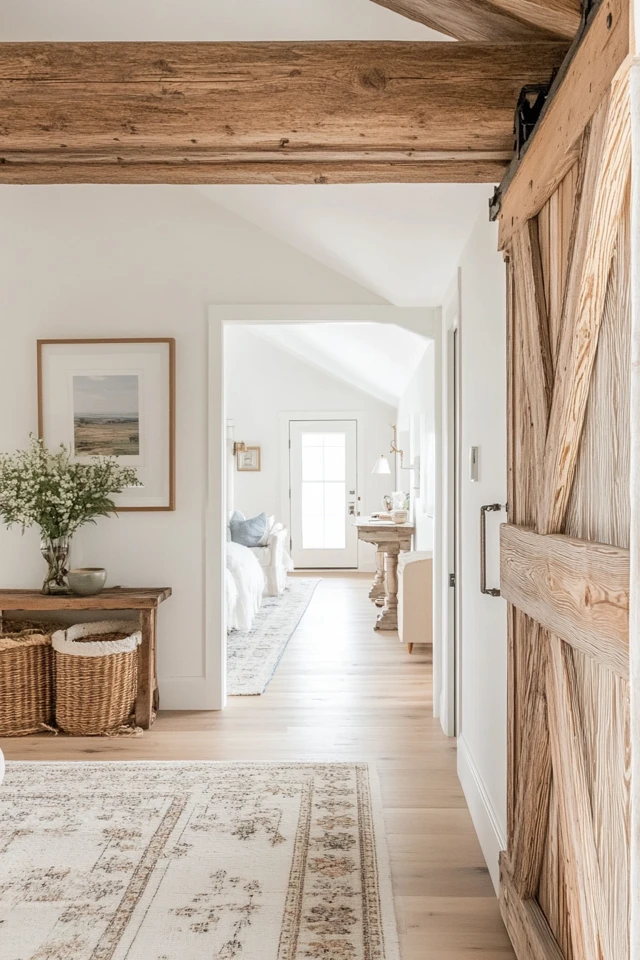
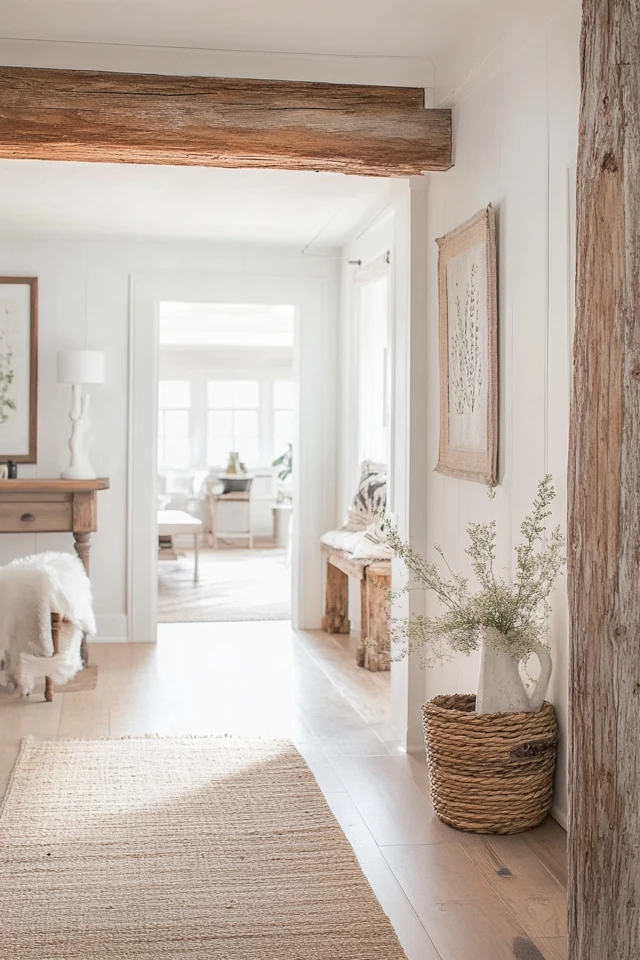
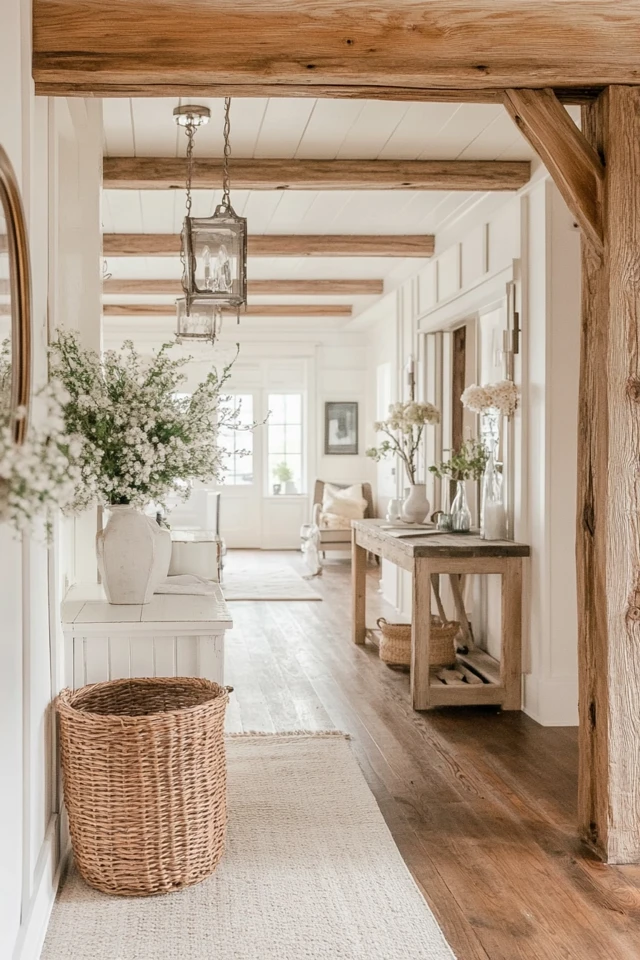
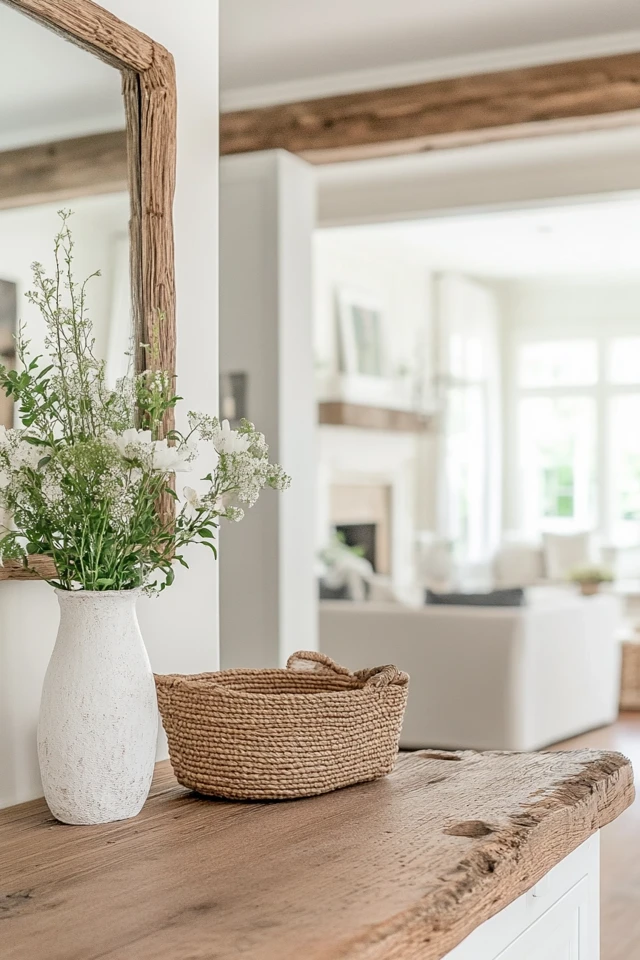
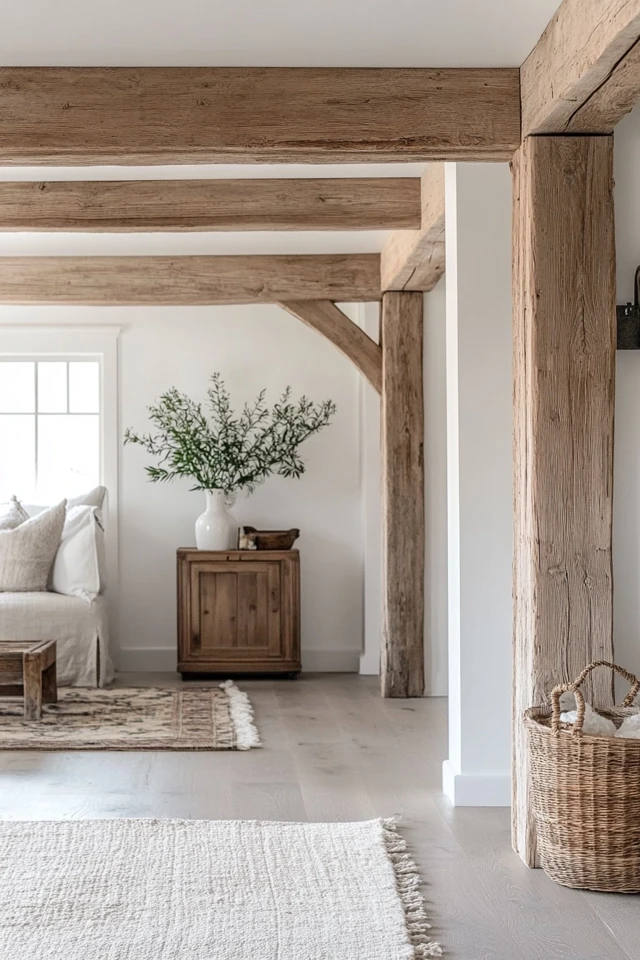
Why These Key Elements Work So Well Together
White and wood are a natural pairing because they balance each other so perfectly. Here’s why they work so beautifully in farmhouse interiors:
- Contrast: The brightness of white highlights the richness and warmth of wood, creating visual interest.
- Texture: Wood brings organic texture to the smooth, clean surfaces of white walls, furniture, or cabinetry.
- Versatility: White and wood can be styled for modern, rustic, or vintage farmhouse looks.
- Timeless Appeal: This combination never goes out of style, ensuring your home feels fresh and inviting for years to come.
- Cohesive Design: By using white as a unifying element, you can incorporate different wood tones without the space feeling disjointed.
How to Combine White and Wood in Farmhouse Interiors
1. Start with a White Foundation
- Design: Use white as the base color for walls, ceilings, or large furniture pieces to create a bright and airy backdrop.
- Why It Works: White provides a clean slate that allows wood accents to stand out without overwhelming the space.
- Styling Tips: Consider white shiplap walls, whitewashed brick, or neutral paint tones like soft cream or warm beige.
2. Incorporate Natural Wood Furniture
- Design: Add wooden furniture like dining tables, coffee tables, or chairs to bring warmth and character to the room.
- Why It Works: Natural wood contrasts beautifully with white surfaces, adding depth and texture.
- Styling Tips: Mix wood tones, from light oak to deep walnut, for a layered and dynamic look.
3. Add Exposed Wood Beams or Ceilings
- Design: Use reclaimed wood beams or paneling to highlight architectural features like ceilings or doorways.
- Why It Works: Exposed wood adds rustic charm and emphasizes the farmhouse aesthetic.
- Styling Tips: Pair with white ceilings or walls for a striking contrast that draws the eye upward.
4. Layer White and Wood in the Kitchen
- Design: Combine white cabinets with wooden countertops, shelves, or islands for a cozy and functional farmhouse kitchen.
- Why It Works: The clean look of white cabinetry balances the warmth and texture of wood, creating a welcoming space.
- Styling Tips: Add accents like wooden cutting boards, bar stools, or open shelving to enhance the look.
5. Pair White Upholstery with Wooden Frames
- Design: Use furniture with white cushions or slipcovers paired with wooden frames or legs.
- Why It Works: The softness of white fabrics complements the sturdiness of wood, creating a cozy yet refined look.
- Styling Tips: Add throw pillows or blankets in neutral tones to tie the elements together.
6. Create a Focal Point with Wood Accents
- Design: Use wood as a statement element, like a reclaimed wood mantel, a feature wall, or a large mirror with a wooden frame.
- Why It Works: Wood accents add warmth and visual interest without overpowering the space.
- Styling Tips: Balance bold wood elements with simple white decor for a cohesive design.
7. Incorporate White and Wood Flooring
- Design: Use natural wood flooring paired with white area rugs or tile to create a harmonious foundation.
- Why It Works: The natural grain of wood adds texture, while white accents keep the space light and fresh.
- Styling Tips: Choose wide-plank flooring for a more rustic look or opt for light-stained wood to blend seamlessly with white elements.
8. Mix Wood Tones for Depth
- Design: Combine different wood tones, from light birch to dark mahogany, to create a layered and dynamic look.
- Why It Works: Mixing tones adds richness and prevents the space from feeling too uniform.
- Styling Tips: Use white as a unifying element to ensure the various wood tones work together harmoniously.
9. Decorate with White and Wood Accessories
- Design: Use decor like wooden picture frames, white vases, or a mix of wooden and white candles to tie the theme together.
- Why It Works: Small accessories reinforce the white-and-wood palette without overwhelming the space.
- Styling Tips: Incorporate natural textures like wicker baskets or linen curtains for added depth.
10. Balance White and Wood in Bathrooms
- Design: Pair white subway tile or paint with wooden vanities, mirrors, or shelving for a rustic yet modern bathroom.
- Why It Works: The crispness of white tile is softened by the warmth of wood, creating a spa-like feel.
- Styling Tips: Add greenery or black hardware for contrast and a pop of color.
How to Style White and Wood Interiors
- Add Greenery: Bring life and color to the space with potted plants or fresh flowers.
- Mix Textures: Combine smooth white surfaces with rough-hewn wood for a layered look.
- Play with Proportions: Use white for larger elements like walls or furniture, and add wood accents in smaller doses.
- Use Natural Light: Let sunlight highlight the natural beauty of wood and brighten white surfaces.
- Incorporate Neutral Accents: Use beige, grey, or soft pastels to add subtle color while maintaining the farmhouse aesthetic.
FAQ Section
1. Can I mix different wood tones in the same room?
- Yes! Mixing wood tones adds depth and interest. Use white elements to create cohesion between different shades.
2. How do I keep a white-and-wood space from feeling too cold?
- Incorporate warm wood tones, soft textiles, and cozy lighting to add warmth and balance to the room.
3. What type of wood works best for farmhouse interiors?
- Reclaimed wood, oak, pine, and walnut are popular choices for their natural grain and rustic appeal.
4. How do I clean white furniture and wood surfaces?
- Use gentle cleaners for white surfaces and a wood-safe polish or oil to maintain wood’s natural luster.
5. Can I use white and wood in small spaces?
- Absolutely! White can make a small space feel larger and brighter, while wood adds warmth without overwhelming the room.
Variations
- Modern Farmhouse Look: Pair crisp white walls with light-stained wood and sleek, minimalist furniture.
- Rustic Farmhouse Look: Use reclaimed wood beams, distressed finishes, and cream-colored accents.
- Coastal Farmhouse Look: Incorporate whitewashed wood and light blue tones for a breezy, seaside vibe.
- Industrial Farmhouse Look: Combine white elements with dark-stained wood and black metal accents.
- Boho Farmhouse Look: Add colorful textiles, macramé accents, and layered patterns to soften the white-and-wood palette.
How to Showcase It
- Before-and-After Photos: Highlight the transformation of your space with the addition of white and wood elements.
- Seasonal Styling: Show how white and wood can be styled for different seasons, from cozy fall decor to bright summer accents.
- Layered Textures: Share photos of smooth white finishes paired with rough-hewn wood for a rich, dynamic look.
Occasions to Feature It
- Room Makeovers: Use white and wood to refresh a space with minimal effort.
- Seasonal Decorating: Highlight the versatility of white and wood with seasonal decor.
- Everyday Charm: Enjoy the timeless appeal of white and wood in your daily life.
Conclusion
The combination of white and wood is a cornerstone of farmhouse design, offering a perfect blend of brightness, warmth, and texture. Whether you’re decorating a kitchen, living room, or bedroom, this pairing creates a timeless, welcoming aesthetic that never goes out of style.
From white shiplap walls and wooden beams to natural wood furniture and crisp white accents, the possibilities are endless. Start experimenting with these ideas today, and transform your home into a cozy, farmhouse-inspired retreat.

